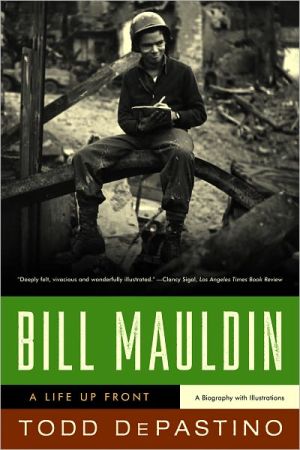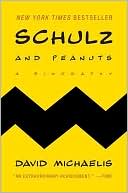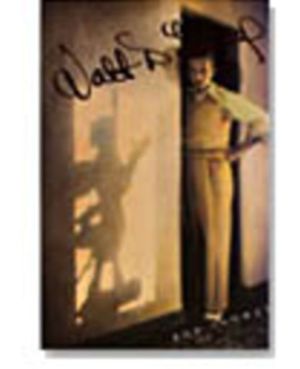Bill Mauldin: A Life Up Front
“A deeply felt, vivacious and wonderfully illustrated biography.” —Clancy Sigal, Los Angeles Times Book Review\ A self-described “desert rat” who rocketed to fame at the age of twenty-two, Bill Mauldin used flashing black brush lines and sardonic captions to capture the world of the American combat soldier in World War II. His cartoon dogfaces, Willie and Joe, appeared in Stars and Stripes and hundreds of newspapers back home, bearing grim witness to life in the foxhole. We’ve never viewed...
Search in google:
“A deeply felt, vivacious and wonderfully illustrated biography.” —Clancy Sigal, Los Angeles Times Book ReviewThe Barnes & Noble ReviewBack at the beginning of this century, someone asked historian Stephen Ambrose to name his candidate for Time magazine's Person of the 20th Century. Without hesitation, he chose "the citizen soldier" -- the enlisted men of the Second World War about whom he wrote in one of his many popular books. No doubt Bill Mauldin -- cartoonist, World War II veteran, and the subject of Todd DePastino's excellent new biography -- would agree with Ambrose's salute to the average G.I. Joe. After all, Mauldin (1921-2003) was essential in creating the very image. His cartoons from the front, published in the service newspapers and reprinted throughout the United States, went far toward explaining the life of the average soldier to his supporters back home. Mauldin himself came from a hardscrabble background similar to many of those men who were sent to the frontline of combat, and his sympathies ran deep, not just because he was a low-level infantryman.
\ EntertainmentDePastino’s bio serves not only as an appreciation of Mauldin’s artistry but also as a complex portrait of an iconoclast who started out as the Greatest Generation’s court jester but grew to become its conscience.— Bob Cannon\ \ \ \ \ Philadelphia InquirerVibrant, moving, and full of wonderful cartoons, DePastino’s book breathes life into a fascinating American genius.— Chris Patsilelis\ \ \ Publishers WeeklyHistorian DePastino (Citizen Hobo) eloquently memorializes cartoonist Bill Mauldin, who won fame as "the leading spokesman for the American combat soldier" during World War II, in this authoritative biography. Mauldin (1921-2003) grew up in Depression-era New Mexico in a dysfunctional family. After studying at the Chicago Academy of Fine Arts for one year, he joined the newly mobilized 45th Infantry Division of the Arizona National Guard. Mauldin then became the 45th Division News's cartoonist. Deployed to North Africa in 1943, Mauldin participated in the invasions of Sicily and Italy. In 1944, while on staff at the GI newspaper Stars and Stripes, Mauldin created his signature characters, the weary and disheveled infantrymen Willie and Joe. Willie and Joe became soldiers' heroes and anathema to brass such as Gen. George Patton, who threatened to throw Mauldin in jail for his characters' indolence. After the war, Mauldin published bestselling cartoon collections, worked briefly as an actor, ran unsuccessfully for Congress and ended his career with two Pulitzer Prizes for editorial cartooning. Thoroughly researched and sprightly written, DePastino's balanced biography is a solid introduction to an American original. Classic Mauldin cartoons are an entertaining bonus. (Feb.)\ Copyright 2007 Reed Business Information\ \ \ \ \ Library JournalDePastino (history, Waynesburg Coll., Pittsburgh; Citizen Hobo) offers the first biography of Mauldin, creator of the wildly popular cartoon strip Upfront, which featured ordinary GIs Willie and Joe during World War II. Unflinchingly, the author writes of the New Mexico boy with little education but plenty of talent and drive who joined the Arizona National Guard for rent money and then entered the army's 45th Infantry Division in World War II. Shipped to North Africa, then Italy, he drew about the grinding war for the soldiers' newspaper, Stars and Stripes, from the soldiers' viewpoint. His lifelong distrust of authority and a penchant for deflating egos led to noisy confrontations with powers such as George Patton, who wanted him arrested. Mauldin was awarded the Pulitzer Prize at age 23. After the war, he was a political cartoonist, editorialist, and favorite on the veterans' circuit. In the Sixties, he first supported the Vietnam War, then turned determinedly against it. This biography does not flinch from Mauldin's tumultuous personal life, marked by three wives and serious alcohol use, but does concentrate on his drawing and writing careers. A lively and thoroughly readable account of an American original illustrated with 90 of Mauldin's drawings; recommended for all libraries.\ —Edwin B. Burgess\ \ \ \ \ \ The Barnes & Noble ReviewBack at the beginning of this century, someone asked historian Stephen Ambrose to name his candidate for Time magazine's Person of the 20th Century. Without hesitation, he chose "the citizen soldier" -- the enlisted men of the Second World War about whom he wrote in one of his many popular books. No doubt Bill Mauldin -- cartoonist, World War II veteran, and the subject of Todd DePastino's excellent new biography -- would agree with Ambrose's salute to the average G.I. Joe. After all, Mauldin (1921-2003) was essential in creating the very image. His cartoons from the front, published in the service newspapers and reprinted throughout the United States, went far toward explaining the life of the average soldier to his supporters back home. Mauldin himself came from a hardscrabble background similar to many of those men who were sent to the frontline of combat, and his sympathies ran deep, not just because he was a low-level infantryman. \ In his engaging and comprehensive biography, DePastino balances his scholarly knowledge of three distinct areas: World War II, the history of cartooning, and the American underclass described so sympathetically in DePastino's first book, Citizen Hobo (2003). The Mauldin clan fit well among the dirt-poor of the American Southwest; Bill and his older brother came of age in New Mexico during the Depression, living with two ne'er-do-well parents given to booze and to disappearing for days on end. Before he reached puberty, young Bill smoked, drank, knew how to drive, and could hunt with the best of them. This helped to make up for the physical reality of being a scrawny, jug-eared runt who was only occasionally protected by his strapping older brother. Fed up with their unreliable parents, the two boys headed to Arizona, where Bill almost finished high school while paying for his room and board by pursuing his developing skill as an artist.\ With pen and paper always in hand, Bill began to learn technique from a cartoon correspondence school, and his talents as an artist and writer were recognized by a few of his local teachers, as well as by "Hillbilly Larry" Smith, a Phoenix gag cartoonist who helped the ambitious 15-year-old find work drawing signs, banners, and posters for local businesses and politicians. Determined to become rich and famous, Bill headed to Chicago's Academy of Fine Arts, which didn't require a high school degree. There, he began to study life drawing and to master the techniques that would distinguish his later cartooning from the style then prominent, the so-called "big-foot" cartoons that substituted exaggerated extremities for realistic features. Mauldin had amazing work habits -- he knocked out ten or more cartoons a night after spending his free hours haunting the newsrooms where working cartoonists freely shared their valuable tips.\ With war on the horizon and not more than a few cartoons sold, Mauldin put aside his dreams and joined the Arizona National Guard, counting on room, board, and the military training and discipline he had enjoyed in high school ROTC. What he found was quite the opposite: lots of Dust Bowl children, poorly equipped, undertrained, and subject to all sorts of absurd regulations, not to mention outright corruption. At Fort Sill, Mauldin began to understand army "chickenshit," the notion that proficiency and intelligence weren't rewarded, but usually led to K.P. or worse. He also discovered military publications. The 45th Division News became Mauldin's first regular cartooning gig, and he expressed his own disillusionment from the get-go. Though the cartoons are busy with text-heavy word balloons, they capture the lower-class diction and slang of the camp. The gripes are familiar: bad food, poor hygiene, inadequate uniforms, and guard duty. But most of all, Mauldin resented the MPs, inspectors, and assorted "ossifers" who ran roughshod over the enlisted men, exercising their power with callous disregard for the average soldier.\ Mauldin learned two things in camp that would fuel his entire career as a soldier-cartoonist: that the rear echelon considers the combat grunts -- Mauldin's "dogfaces" -- to be battle fodder. He also understood what we all now know, that truth is the first casualty of war. Both insights would lead him into all sorts of trouble -- and also to great success. As Mauldin moved closer to the battle front, his cartooning grew by leaps and bounds, both in style and content. Inspired by the American Indians, Mexican Americans, and working-class fellows who made up his company of infantrymen, Mauldin dropped the cheap ethnic jokes and began to eschew humor altogether. A close friend introduced him to Daumier, Hogarth, and other artists of almost documentary-like skill. After a series of cartoons on maneuvers in Louisiana drew some regional acclaim, Mauldin shipped overseas, leaving behind the first of his three wives, who was pregnant with the first of his eight children.\ First in Algiers, then Sicily, and eventually at Anzio and Paris, Mauldin cranked out drawings at phenomenal speed. They were often printed as part of a guerrilla-style publishing outfit, as he and fellow journalists hunted down ink, paper, and presses among the bombarded towns, eventually setting up a Mediterranean edition of Stars and Stripes. His cartoons for the Universal Press syndicate, titled "Star-Spangled Banter," were given a major boost by that other poet of the dogface, Ernie Pyle, whose profile of wonder boy Mauldin ran in hundreds of papers. While Mauldin suffered the indignities of infantry life, his work was exploding on the American scene, and the money piled up for his family.\ The best part of DePastino's narrative explains Mauldin's difficult relation with the brass. General Patton loathed Willie and Joe, the two tired, unshaven, poorly dressed infantrymen who were the central characters of Mauldin's cartoons. The legendary general did everything he could to silence the outspoken cartoonist, whose increasing realism didn't jibe with Patton's vision of spit-clean, ramrod-straight troops. But Mauldin had his admirers among the top dogs: one arranged for him to travel with his own jeep; another provided art supplies. And General Eisenhower himself eventually told Patton to desist. Like a number of benevolent officers, Ike believed that Mauldin's depictions of muddy landscapes and ruined villages, along with his weary G.I.s, were good for morale and also served the cause at home when enthusiasm for the war was flagging.\ Of course, military control of information prevented Mauldin from drawing the full horror of what he saw. But his Pulitzer Prizewinning cartoon of 1944 is pretty bleak, depicting a scruffy Joe escorting some equally ragged German prisoners. The youngest person ever to win the award, Mauldin came back to the States rich and famous, and he proceeded to capitalize on that for years to come with successful books, such as Up Front (1945), Back Home (1947), and The Brass Ring (1971), which combine his journalistic and artistic skills. DePastino doesn't waste a lot of time on Mauldin's postwar career, though it includes a number of interesting episodes: a sojourn in Hollywood, a credible run for Congress in New York, stints as an editorial cartoonist (with a second Pulitzer-winning cartoon), flirtations with the counterculture, and retirement back where he began -- as a self-described Southwestern "shitkicker."\ DePastino includes many of the seminal cartoons in his fine biography, but to see the full extent of Mauldin's wartime achievement, you must indulge in the massive two-volume collection from Fantagraphics, Willie & Joe: The WWII Years. Here are both the cartoons very much of their time as well as those that deserve a place in American cultural history for their timeless truths. They're expertly edited by DePastino himself, with superb annotations explaining arcane military references. Mauldin's stylistic development becomes clear -- from his cartoony beginnings to his subtle and expressionist drawings at the height of his career. You witness too his turn from a smart-alecky 19-year-old gag writer to a mature and war-wizened man of few words. In the Fantagraphics set, DePastino truncates his full-length biography in a smart introduction, all the time keeping at the fore the most important fact: the uniquely American nature of Mauldin's remarkable achievement. --Thomas DePietro\ Thomas DePietro, a former contributing editor of Kirkus Reviews, has also published in Commonweal, The Nation, and The New York Times Book Review. He recently edited Conversations with Don DeLillo, and his book on Kingsley Amis is forthcoming in 2008.\ \ \







